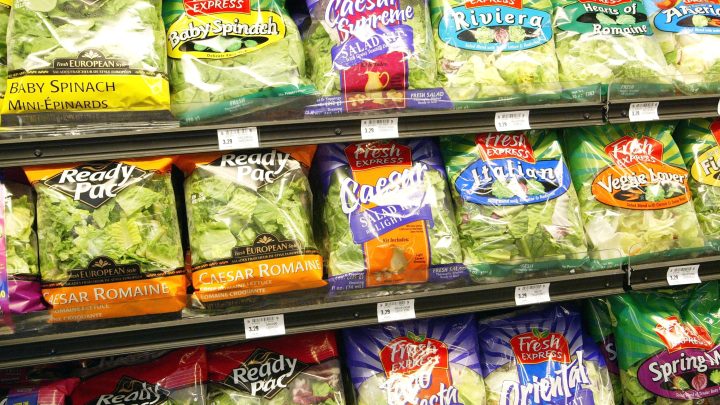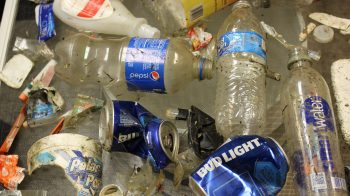
Why is there so much plastic in the produce aisle?

When you enter the produce aisle at your local grocery store, chances are you’ll see a lot of plastic. From bagged salads to berries in clamshells, plastic is prolific where Americans shop for food.
The material, of course, is bad for the environment. Plastic production releases harmful greenhouse gas emissions and the plastic from packaging and other uses often ends up polluting our oceans and rivers. But saving the planet won’t be as simple as swapping plastic for biodegradable alternatives.
“Marketplace” host Amy Scott spoke with Kim Severson, national food correspondent at The New York Times, about her piece on some of the costs and benefits of plastic packaging. Below is an edited transcript of their conversation.
Amy Scott: So, when I go shopping for produce, I have noticed that everything pretty much seems to be wrapped in plastic. Why is that?
Kim Severson: Well, plastic works really well in a lot of ways, right? It keeps your food from spoiling. And if you think about Peru and blueberries, where much of America’s blueberries come from, you got to get those blueberries from Peru to your local store in decent shape, right? Well, plastic is really the way that happens.
Scott: But we’re also seeing the downsides of plastic. It’s choking the oceans, the carbon footprint is enormous. But you write that it’s a little more challenging to move on to a different kind of packaging than we might think. Why is that?
Severson: Right. I mean, I think even people who traffic in plastic will agree that plastic has choked our planet. But really, we’re starting to see that it does have some good applications. For example, you know, those cucumbers that go bad quickly in your refrigerator. When you throw them out, they go into the landfills. And food waste is a big contributor to methane emissions, which is contributing, obviously, to climate change. And the other thing about food waste is you have to think about the amount of money and energy it took to farm that cucumber and to transport it. All of that impacts the climate too. So, if we’re wasting 30% of our food by throwing it away, that’s essentially 30% of the inputs it takes to create that food too.
Scott: So what alternatives are out there that could preserve freshness, and maybe the convenience that consumers really seem to want, but aren’t so harmful to the environment?
Severson: There are a whole lot of different materials being worked on. One thing I kind of like is the idea of using orange peels or shrimp shells or other kinds of waste that get turned into a film that can be used kind of like cellophane or can be made into bags. And of course, there are all kinds of containers from when rice is harvested or the leftover straw from grass or sugar cane. All of this is being turned into trays and boxes in an attempt to make them biodegradable.
Scott: This seems like one of those, you know, putting-the-genie-back-in-the-bottle situations. By that I mean is some of this going to take consumers giving up having blueberries in the winter, for example? Or maybe buying more carefully and not letting things sit in their fridge for two weeks and turn into mush?
Severson: Well, you are a dreamer. Let’s think about this. American shoppers bought $4.3 billion worth of bag salads last year, right? So, the bag salad industry, the clamshells or the bags, I don’t think that is really going to go away. But I think in the same way that we all started to carry our public radio tote bags to the grocery store instead of using a plastic bag, that I think is consumer behavior change. And I think people are increasingly not happy that they have to buy 12 jalapenos in a Styrofoam plastic-covered container when they really just need two. People are starting to actually push back and make the choice. But the fact of the matter is, these regulations and these changes are going to come. The [Joe] Biden administration has a food waste plan that is calling for innovations in packaging as well as limiting food waste. So I think the tide is turning. But you’ve got to learn to clean your own romaine. That’s the bottom line.
Scott: And that leads me to the last question, which is the cost. I mean, as these changes happen, whether we push for them or not, do you expect we will pay more for produce as a result?
Severson: I think that there will be a shift to people wanting to buy less produce because they don’t want to buy the big amounts you would have to. So that would save the consumer some dollars. But listen, prices are up all over the place. Inflation is happening at the grocery store. And, you know, the bottom line is it’s going to cost more to have your fruit packaged in something other than plastic. So yeah, I think it’s going to cost consumers at the grocery store. But I also think there are ways that we can limit how much money we’re spending by being a little more thoughtful about saving those scraps and cooking with them or about making sure you eat what’s in your refrigerator instead of going out. So I think there’s some ways that we as consumers and cooks can make a difference too and save ourselves some money.
There’s a lot happening in the world. Through it all, Marketplace is here for you.
You rely on Marketplace to break down the world’s events and tell you how it affects you in a fact-based, approachable way. We rely on your financial support to keep making that possible.
Your donation today powers the independent journalism that you rely on. For just $5/month, you can help sustain Marketplace so we can keep reporting on the things that matter to you.

















